Financial Planning Diploma: Module 4 Insurance Assessment - FNSFPL504
VerifiedAdded on 2023/06/14
|30
|8647
|293
Homework Assignment
AI Summary
This assignment solution for Diploma of Financial Planning Module 4 focuses on insurance fundamentals and includes several assessment activities. It covers general and personal insurance policies, including Term Life, TPD, Critical Illness, and Income Protection. The assignment requires students to describe insurance policies applicable to different scenarios, analyze risks associated with owning an asset like a plane, and understand how insurance companies handle underinsurance. The tax implications of income protection policies and the importance of a reasonable basis for advice in Statement of Advice (SOA) documents are also explored. The document includes a declaration of authenticity.
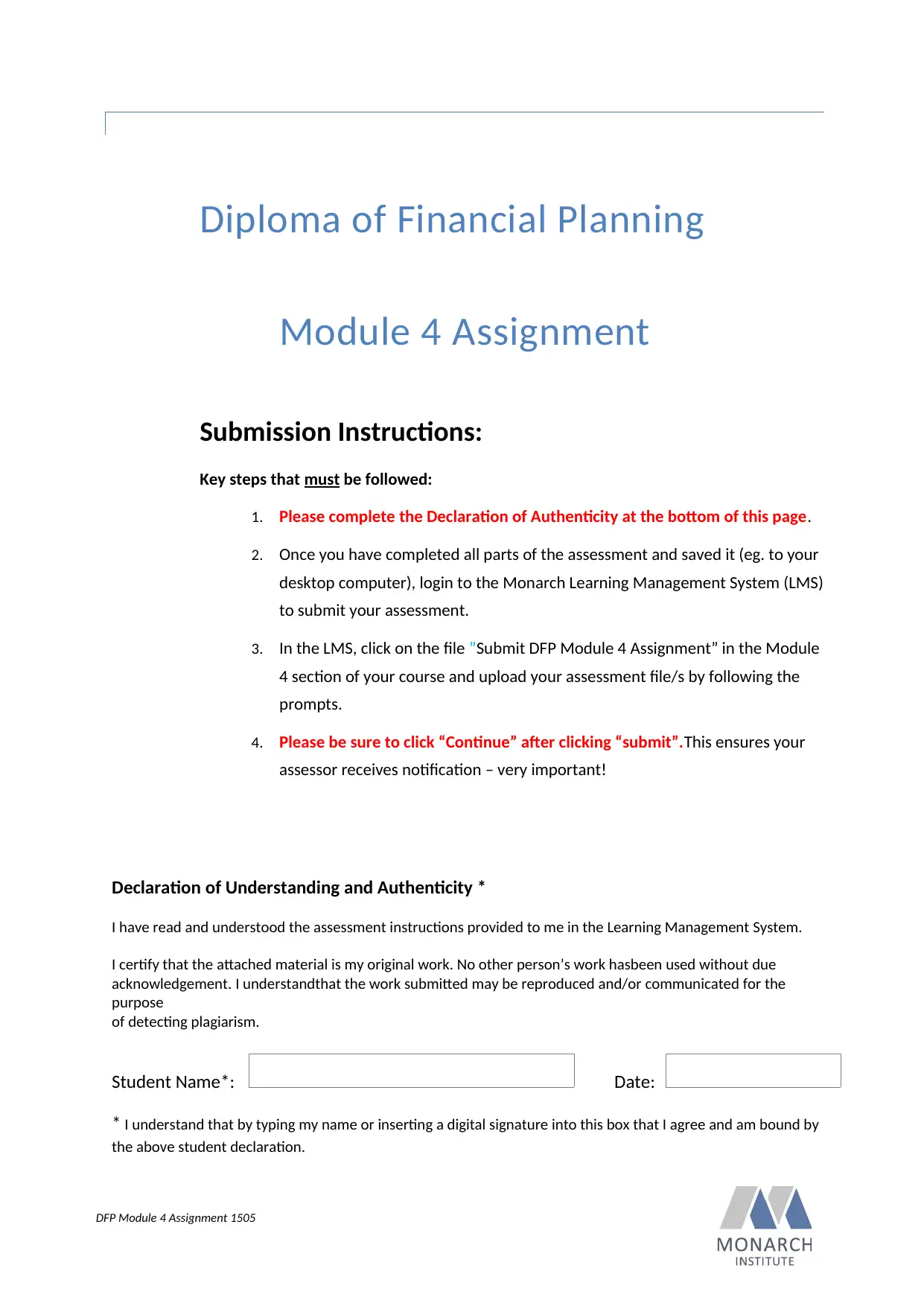
DFP Module 4 Assignment 1505
Diploma of Financial Planning
Module 4 Assignment
Submission Instructions:
Key steps that must be followed:
1. Please complete the Declaration of Authenticity at the bottom of this page.
2. Once you have completed all parts of the assessment and saved it (eg. to your
desktop computer), login to the Monarch Learning Management System (LMS)
to submit your assessment.
3. In the LMS, click on the file ”Submit DFP Module 4 Assignment” in the Module
4 section of your course and upload your assessment file/s by following the
prompts.
4. Please be sure to click “Continue” after clicking “submit”.This ensures your
assessor receives notification – very important!
Declaration of Understanding and Authenticity *
I have read and understood the assessment instructions provided to me in the Learning Management System.
I certify that the attached material is my original work. No other person’s work hasbeen used without due
acknowledgement. I understandthat the work submitted may be reproduced and/or communicated for the
purpose
of detecting plagiarism.
Student Name*: Date:
* I understand that by typing my name or inserting a digital signature into this box that I agree and am bound by
the above student declaration.
Diploma of Financial Planning
Module 4 Assignment
Submission Instructions:
Key steps that must be followed:
1. Please complete the Declaration of Authenticity at the bottom of this page.
2. Once you have completed all parts of the assessment and saved it (eg. to your
desktop computer), login to the Monarch Learning Management System (LMS)
to submit your assessment.
3. In the LMS, click on the file ”Submit DFP Module 4 Assignment” in the Module
4 section of your course and upload your assessment file/s by following the
prompts.
4. Please be sure to click “Continue” after clicking “submit”.This ensures your
assessor receives notification – very important!
Declaration of Understanding and Authenticity *
I have read and understood the assessment instructions provided to me in the Learning Management System.
I certify that the attached material is my original work. No other person’s work hasbeen used without due
acknowledgement. I understandthat the work submitted may be reproduced and/or communicated for the
purpose
of detecting plagiarism.
Student Name*: Date:
* I understand that by typing my name or inserting a digital signature into this box that I agree and am bound by
the above student declaration.
Paraphrase This Document
Need a fresh take? Get an instant paraphrase of this document with our AI Paraphraser
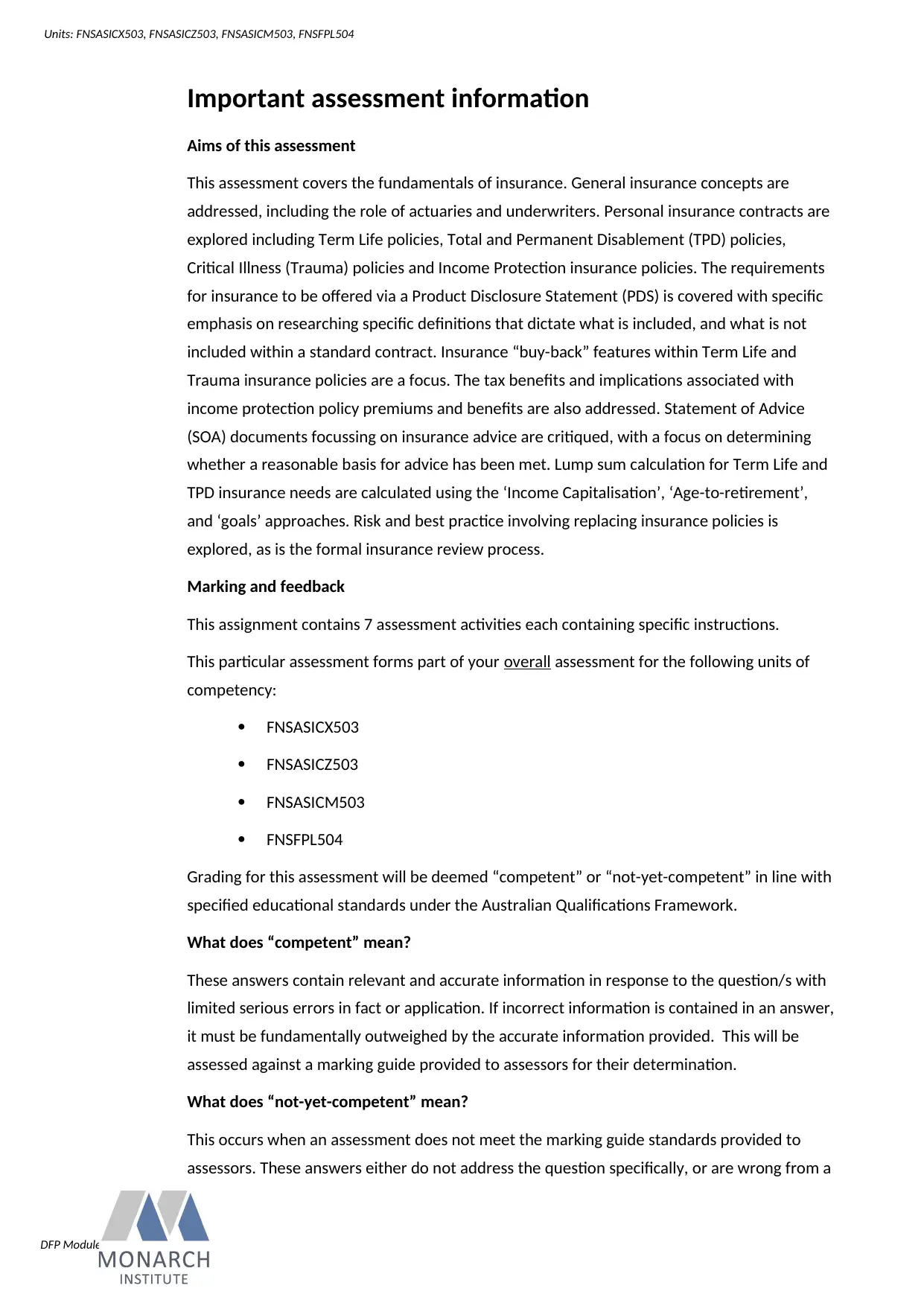
DFP Module 4 Assignment 1601
Units: FNSASICX503, FNSASICZ503, FNSASICM503, FNSFPL504
Important assessment information
Aims of this assessment
This assessment covers the fundamentals of insurance. General insurance concepts are
addressed, including the role of actuaries and underwriters. Personal insurance contracts are
explored including Term Life policies, Total and Permanent Disablement (TPD) policies,
Critical Illness (Trauma) policies and Income Protection insurance policies. The requirements
for insurance to be offered via a Product Disclosure Statement (PDS) is covered with specific
emphasis on researching specific definitions that dictate what is included, and what is not
included within a standard contract. Insurance “buy-back” features within Term Life and
Trauma insurance policies are a focus. The tax benefits and implications associated with
income protection policy premiums and benefits are also addressed. Statement of Advice
(SOA) documents focussing on insurance advice are critiqued, with a focus on determining
whether a reasonable basis for advice has been met. Lump sum calculation for Term Life and
TPD insurance needs are calculated using the ‘Income Capitalisation’, ‘Age-to-retirement’,
and ‘goals’ approaches. Risk and best practice involving replacing insurance policies is
explored, as is the formal insurance review process.
Marking and feedback
This assignment contains 7 assessment activities each containing specific instructions.
This particular assessment forms part of your overall assessment for the following units of
competency:
FNSASICX503
FNSASICZ503
FNSASICM503
FNSFPL504
Grading for this assessment will be deemed “competent” or “not-yet-competent” in line with
specified educational standards under the Australian Qualifications Framework.
What does “competent” mean?
These answers contain relevant and accurate information in response to the question/s with
limited serious errors in fact or application. If incorrect information is contained in an answer,
it must be fundamentally outweighed by the accurate information provided. This will be
assessed against a marking guide provided to assessors for their determination.
What does “not-yet-competent” mean?
This occurs when an assessment does not meet the marking guide standards provided to
assessors. These answers either do not address the question specifically, or are wrong from a
Units: FNSASICX503, FNSASICZ503, FNSASICM503, FNSFPL504
Important assessment information
Aims of this assessment
This assessment covers the fundamentals of insurance. General insurance concepts are
addressed, including the role of actuaries and underwriters. Personal insurance contracts are
explored including Term Life policies, Total and Permanent Disablement (TPD) policies,
Critical Illness (Trauma) policies and Income Protection insurance policies. The requirements
for insurance to be offered via a Product Disclosure Statement (PDS) is covered with specific
emphasis on researching specific definitions that dictate what is included, and what is not
included within a standard contract. Insurance “buy-back” features within Term Life and
Trauma insurance policies are a focus. The tax benefits and implications associated with
income protection policy premiums and benefits are also addressed. Statement of Advice
(SOA) documents focussing on insurance advice are critiqued, with a focus on determining
whether a reasonable basis for advice has been met. Lump sum calculation for Term Life and
TPD insurance needs are calculated using the ‘Income Capitalisation’, ‘Age-to-retirement’,
and ‘goals’ approaches. Risk and best practice involving replacing insurance policies is
explored, as is the formal insurance review process.
Marking and feedback
This assignment contains 7 assessment activities each containing specific instructions.
This particular assessment forms part of your overall assessment for the following units of
competency:
FNSASICX503
FNSASICZ503
FNSASICM503
FNSFPL504
Grading for this assessment will be deemed “competent” or “not-yet-competent” in line with
specified educational standards under the Australian Qualifications Framework.
What does “competent” mean?
These answers contain relevant and accurate information in response to the question/s with
limited serious errors in fact or application. If incorrect information is contained in an answer,
it must be fundamentally outweighed by the accurate information provided. This will be
assessed against a marking guide provided to assessors for their determination.
What does “not-yet-competent” mean?
This occurs when an assessment does not meet the marking guide standards provided to
assessors. These answers either do not address the question specifically, or are wrong from a
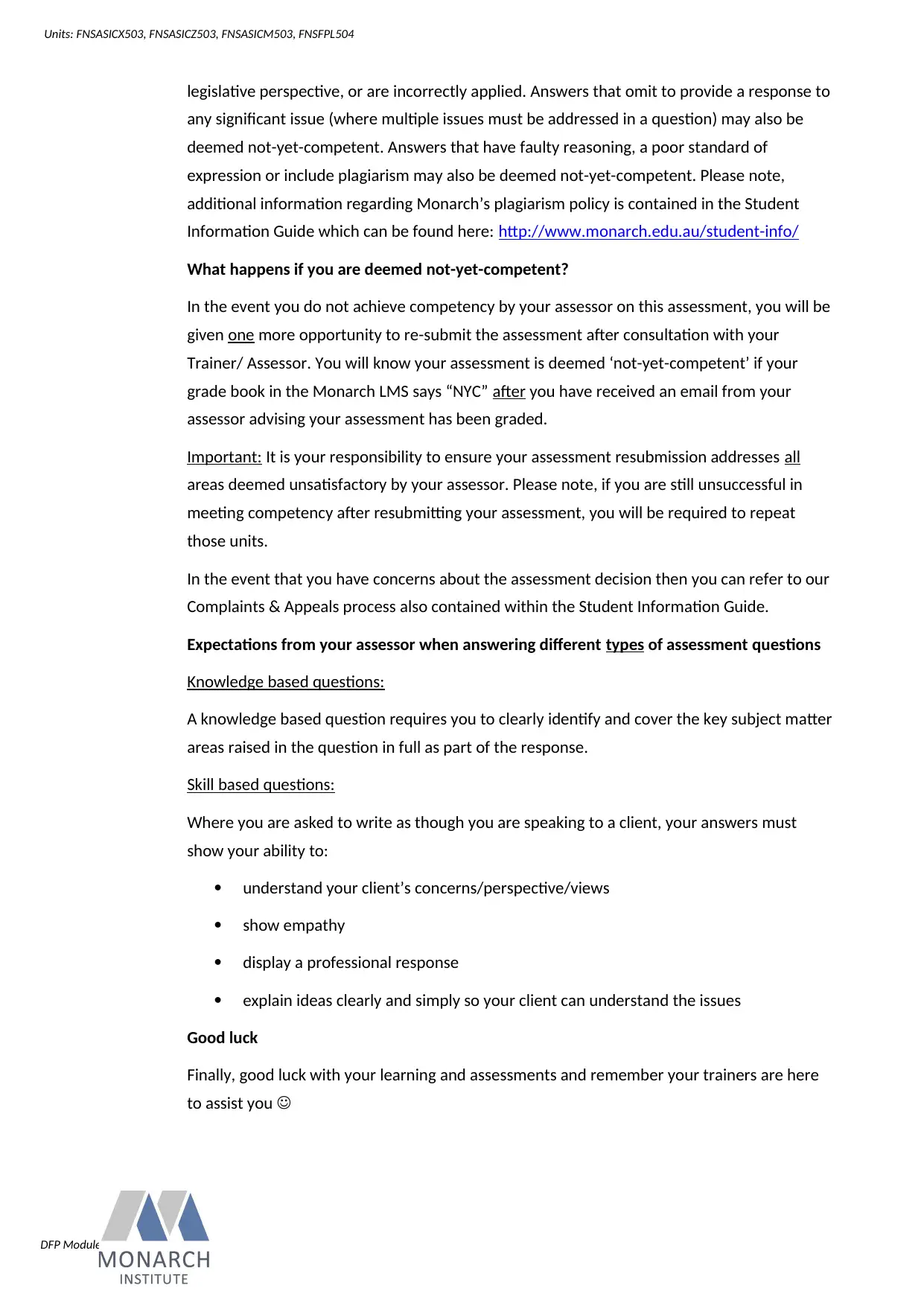
DFP Module 4 Assignment 1601
Units: FNSASICX503, FNSASICZ503, FNSASICM503, FNSFPL504
legislative perspective, or are incorrectly applied. Answers that omit to provide a response to
any significant issue (where multiple issues must be addressed in a question) may also be
deemed not-yet-competent. Answers that have faulty reasoning, a poor standard of
expression or include plagiarism may also be deemed not-yet-competent. Please note,
additional information regarding Monarch’s plagiarism policy is contained in the Student
Information Guide which can be found here: http://www.monarch.edu.au/student-info/
What happens if you are deemed not-yet-competent?
In the event you do not achieve competency by your assessor on this assessment, you will be
given one more opportunity to re-submit the assessment after consultation with your
Trainer/ Assessor. You will know your assessment is deemed ‘not-yet-competent’ if your
grade book in the Monarch LMS says “NYC” after you have received an email from your
assessor advising your assessment has been graded.
Important: It is your responsibility to ensure your assessment resubmission addresses all
areas deemed unsatisfactory by your assessor. Please note, if you are still unsuccessful in
meeting competency after resubmitting your assessment, you will be required to repeat
those units.
In the event that you have concerns about the assessment decision then you can refer to our
Complaints & Appeals process also contained within the Student Information Guide.
Expectations from your assessor when answering different types of assessment questions
Knowledge based questions:
A knowledge based question requires you to clearly identify and cover the key subject matter
areas raised in the question in full as part of the response.
Skill based questions:
Where you are asked to write as though you are speaking to a client, your answers must
show your ability to:
understand your client’s concerns/perspective/views
show empathy
display a professional response
explain ideas clearly and simply so your client can understand the issues
Good luck
Finally, good luck with your learning and assessments and remember your trainers are here
to assist you
Units: FNSASICX503, FNSASICZ503, FNSASICM503, FNSFPL504
legislative perspective, or are incorrectly applied. Answers that omit to provide a response to
any significant issue (where multiple issues must be addressed in a question) may also be
deemed not-yet-competent. Answers that have faulty reasoning, a poor standard of
expression or include plagiarism may also be deemed not-yet-competent. Please note,
additional information regarding Monarch’s plagiarism policy is contained in the Student
Information Guide which can be found here: http://www.monarch.edu.au/student-info/
What happens if you are deemed not-yet-competent?
In the event you do not achieve competency by your assessor on this assessment, you will be
given one more opportunity to re-submit the assessment after consultation with your
Trainer/ Assessor. You will know your assessment is deemed ‘not-yet-competent’ if your
grade book in the Monarch LMS says “NYC” after you have received an email from your
assessor advising your assessment has been graded.
Important: It is your responsibility to ensure your assessment resubmission addresses all
areas deemed unsatisfactory by your assessor. Please note, if you are still unsuccessful in
meeting competency after resubmitting your assessment, you will be required to repeat
those units.
In the event that you have concerns about the assessment decision then you can refer to our
Complaints & Appeals process also contained within the Student Information Guide.
Expectations from your assessor when answering different types of assessment questions
Knowledge based questions:
A knowledge based question requires you to clearly identify and cover the key subject matter
areas raised in the question in full as part of the response.
Skill based questions:
Where you are asked to write as though you are speaking to a client, your answers must
show your ability to:
understand your client’s concerns/perspective/views
show empathy
display a professional response
explain ideas clearly and simply so your client can understand the issues
Good luck
Finally, good luck with your learning and assessments and remember your trainers are here
to assist you
⊘ This is a preview!⊘
Do you want full access?
Subscribe today to unlock all pages.

Trusted by 1+ million students worldwide
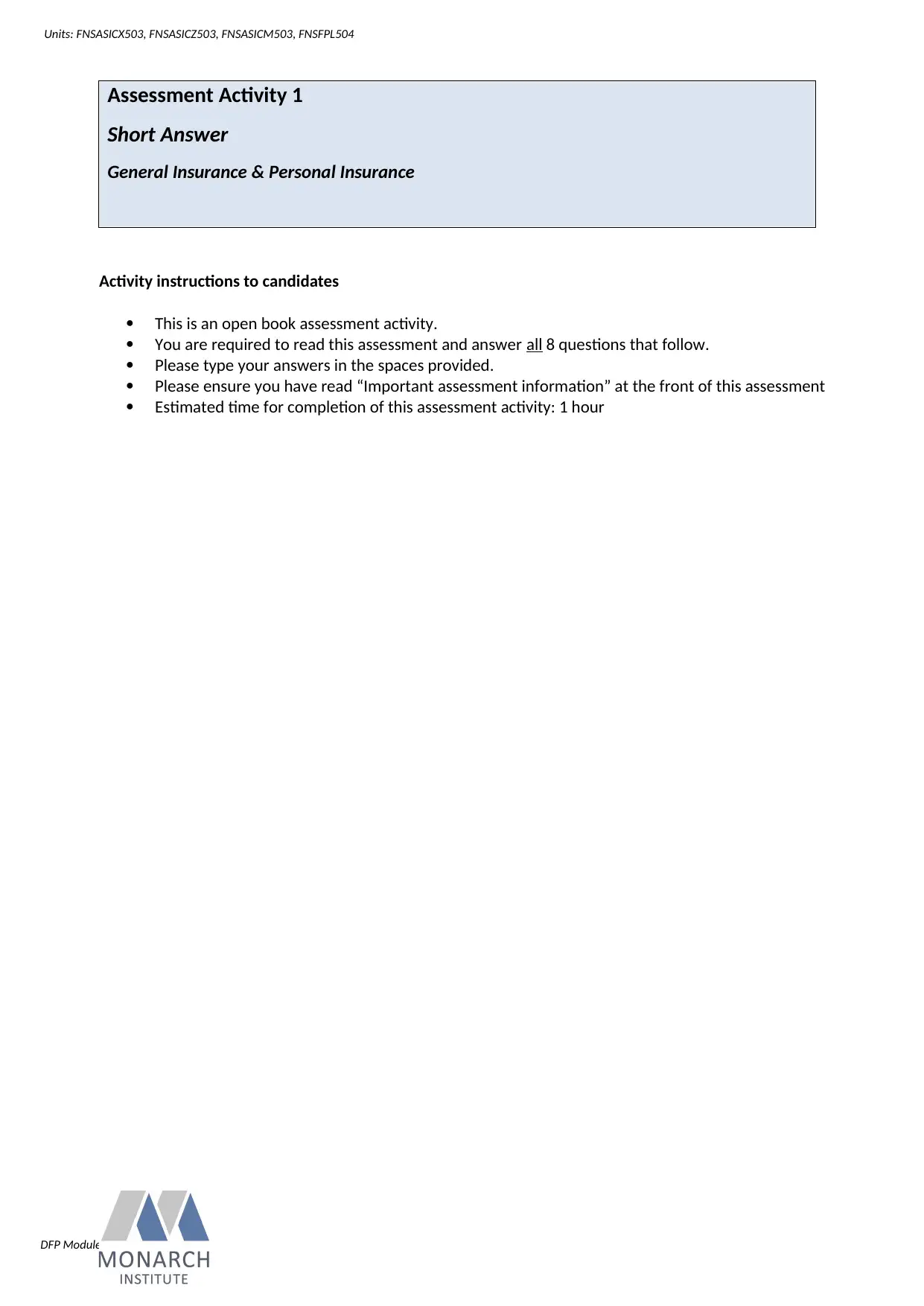
DFP Module 4 Assignment 1601
Units: FNSASICX503, FNSASICZ503, FNSASICM503, FNSFPL504
Assessment Activity 1
Short Answer
General Insurance & Personal Insurance
Activity instructions to candidates
This is an open book assessment activity.
You are required to read this assessment and answer all 8 questions that follow.
Please type your answers in the spaces provided.
Please ensure you have read “Important assessment information” at the front of this assessment
Estimated time for completion of this assessment activity: 1 hour
Units: FNSASICX503, FNSASICZ503, FNSASICM503, FNSFPL504
Assessment Activity 1
Short Answer
General Insurance & Personal Insurance
Activity instructions to candidates
This is an open book assessment activity.
You are required to read this assessment and answer all 8 questions that follow.
Please type your answers in the spaces provided.
Please ensure you have read “Important assessment information” at the front of this assessment
Estimated time for completion of this assessment activity: 1 hour
Paraphrase This Document
Need a fresh take? Get an instant paraphrase of this document with our AI Paraphraser
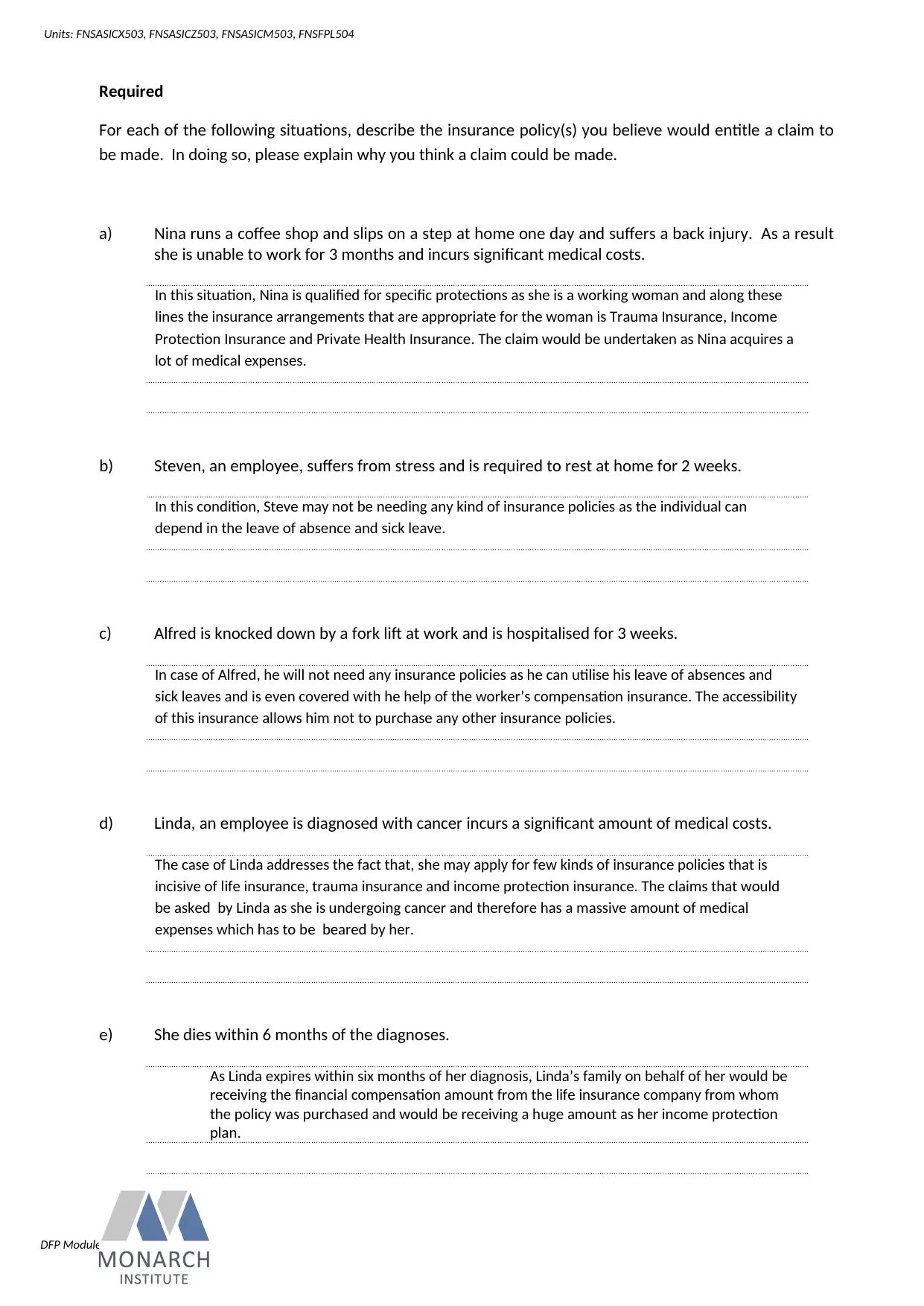
DFP Module 4 Assignment 1601
Units: FNSASICX503, FNSASICZ503, FNSASICM503, FNSFPL504
Required
For each of the following situations, describe the insurance policy(s) you believe would entitle a claim to
be made. In doing so, please explain why you think a claim could be made.
a) Nina runs a coffee shop and slips on a step at home one day and suffers a back injury. As a result
she is unable to work for 3 months and incurs significant medical costs.
In this situation, Nina is qualified for specific protections as she is a working woman and along these
lines the insurance arrangements that are appropriate for the woman is Trauma Insurance, Income
Protection Insurance and Private Health Insurance. The claim would be undertaken as Nina acquires a
lot of medical expenses.
b) Steven, an employee, suffers from stress and is required to rest at home for 2 weeks.
In this condition, Steve may not be needing any kind of insurance policies as the individual can
depend in the leave of absence and sick leave.
c) Alfred is knocked down by a fork lift at work and is hospitalised for 3 weeks.
In case of Alfred, he will not need any insurance policies as he can utilise his leave of absences and
sick leaves and is even covered with he help of the worker’s compensation insurance. The accessibility
of this insurance allows him not to purchase any other insurance policies.
d) Linda, an employee is diagnosed with cancer incurs a significant amount of medical costs.
The case of Linda addresses the fact that, she may apply for few kinds of insurance policies that is
incisive of life insurance, trauma insurance and income protection insurance. The claims that would
be asked by Linda as she is undergoing cancer and therefore has a massive amount of medical
expenses which has to be beared by her.
e) She dies within 6 months of the diagnoses.
As Linda expires within six months of her diagnosis, Linda’s family on behalf of her would be
receiving the financial compensation amount from the life insurance company from whom
the policy was purchased and would be receiving a huge amount as her income protection
plan.
Units: FNSASICX503, FNSASICZ503, FNSASICM503, FNSFPL504
Required
For each of the following situations, describe the insurance policy(s) you believe would entitle a claim to
be made. In doing so, please explain why you think a claim could be made.
a) Nina runs a coffee shop and slips on a step at home one day and suffers a back injury. As a result
she is unable to work for 3 months and incurs significant medical costs.
In this situation, Nina is qualified for specific protections as she is a working woman and along these
lines the insurance arrangements that are appropriate for the woman is Trauma Insurance, Income
Protection Insurance and Private Health Insurance. The claim would be undertaken as Nina acquires a
lot of medical expenses.
b) Steven, an employee, suffers from stress and is required to rest at home for 2 weeks.
In this condition, Steve may not be needing any kind of insurance policies as the individual can
depend in the leave of absence and sick leave.
c) Alfred is knocked down by a fork lift at work and is hospitalised for 3 weeks.
In case of Alfred, he will not need any insurance policies as he can utilise his leave of absences and
sick leaves and is even covered with he help of the worker’s compensation insurance. The accessibility
of this insurance allows him not to purchase any other insurance policies.
d) Linda, an employee is diagnosed with cancer incurs a significant amount of medical costs.
The case of Linda addresses the fact that, she may apply for few kinds of insurance policies that is
incisive of life insurance, trauma insurance and income protection insurance. The claims that would
be asked by Linda as she is undergoing cancer and therefore has a massive amount of medical
expenses which has to be beared by her.
e) She dies within 6 months of the diagnoses.
As Linda expires within six months of her diagnosis, Linda’s family on behalf of her would be
receiving the financial compensation amount from the life insurance company from whom
the policy was purchased and would be receiving a huge amount as her income protection
plan.
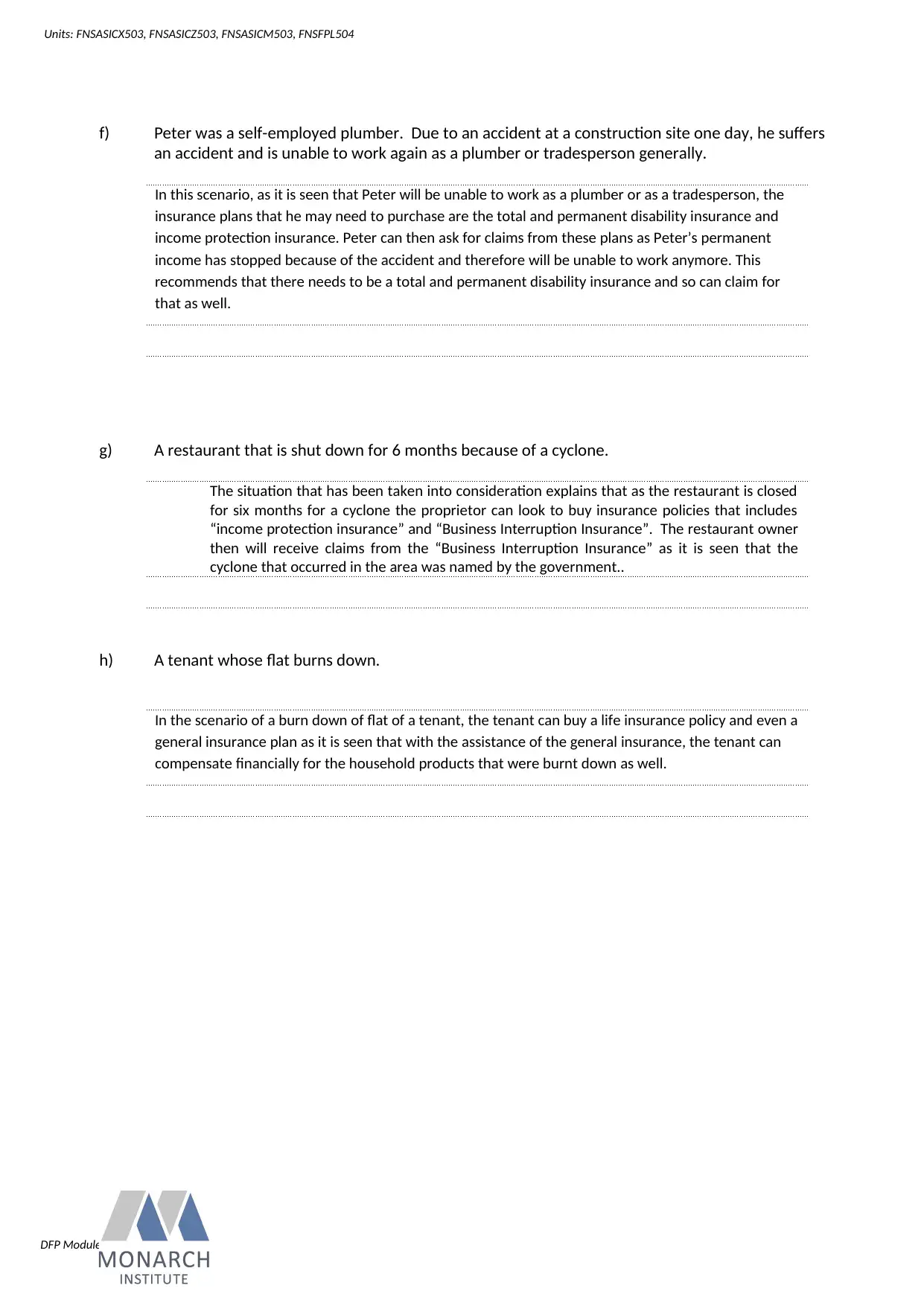
DFP Module 4 Assignment 1601
Units: FNSASICX503, FNSASICZ503, FNSASICM503, FNSFPL504
f) Peter was a self-employed plumber. Due to an accident at a construction site one day, he suffers
an accident and is unable to work again as a plumber or tradesperson generally.
In this scenario, as it is seen that Peter will be unable to work as a plumber or as a tradesperson, the
insurance plans that he may need to purchase are the total and permanent disability insurance and
income protection insurance. Peter can then ask for claims from these plans as Peter’s permanent
income has stopped because of the accident and therefore will be unable to work anymore. This
recommends that there needs to be a total and permanent disability insurance and so can claim for
that as well.
g) A restaurant that is shut down for 6 months because of a cyclone.
The situation that has been taken into consideration explains that as the restaurant is closed
for six months for a cyclone the proprietor can look to buy insurance policies that includes
“income protection insurance” and “Business Interruption Insurance”. The restaurant owner
then will receive claims from the “Business Interruption Insurance” as it is seen that the
cyclone that occurred in the area was named by the government..
h) A tenant whose flat burns down.
In the scenario of a burn down of flat of a tenant, the tenant can buy a life insurance policy and even a
general insurance plan as it is seen that with the assistance of the general insurance, the tenant can
compensate financially for the household products that were burnt down as well.
Units: FNSASICX503, FNSASICZ503, FNSASICM503, FNSFPL504
f) Peter was a self-employed plumber. Due to an accident at a construction site one day, he suffers
an accident and is unable to work again as a plumber or tradesperson generally.
In this scenario, as it is seen that Peter will be unable to work as a plumber or as a tradesperson, the
insurance plans that he may need to purchase are the total and permanent disability insurance and
income protection insurance. Peter can then ask for claims from these plans as Peter’s permanent
income has stopped because of the accident and therefore will be unable to work anymore. This
recommends that there needs to be a total and permanent disability insurance and so can claim for
that as well.
g) A restaurant that is shut down for 6 months because of a cyclone.
The situation that has been taken into consideration explains that as the restaurant is closed
for six months for a cyclone the proprietor can look to buy insurance policies that includes
“income protection insurance” and “Business Interruption Insurance”. The restaurant owner
then will receive claims from the “Business Interruption Insurance” as it is seen that the
cyclone that occurred in the area was named by the government..
h) A tenant whose flat burns down.
In the scenario of a burn down of flat of a tenant, the tenant can buy a life insurance policy and even a
general insurance plan as it is seen that with the assistance of the general insurance, the tenant can
compensate financially for the household products that were burnt down as well.
⊘ This is a preview!⊘
Do you want full access?
Subscribe today to unlock all pages.

Trusted by 1+ million students worldwide
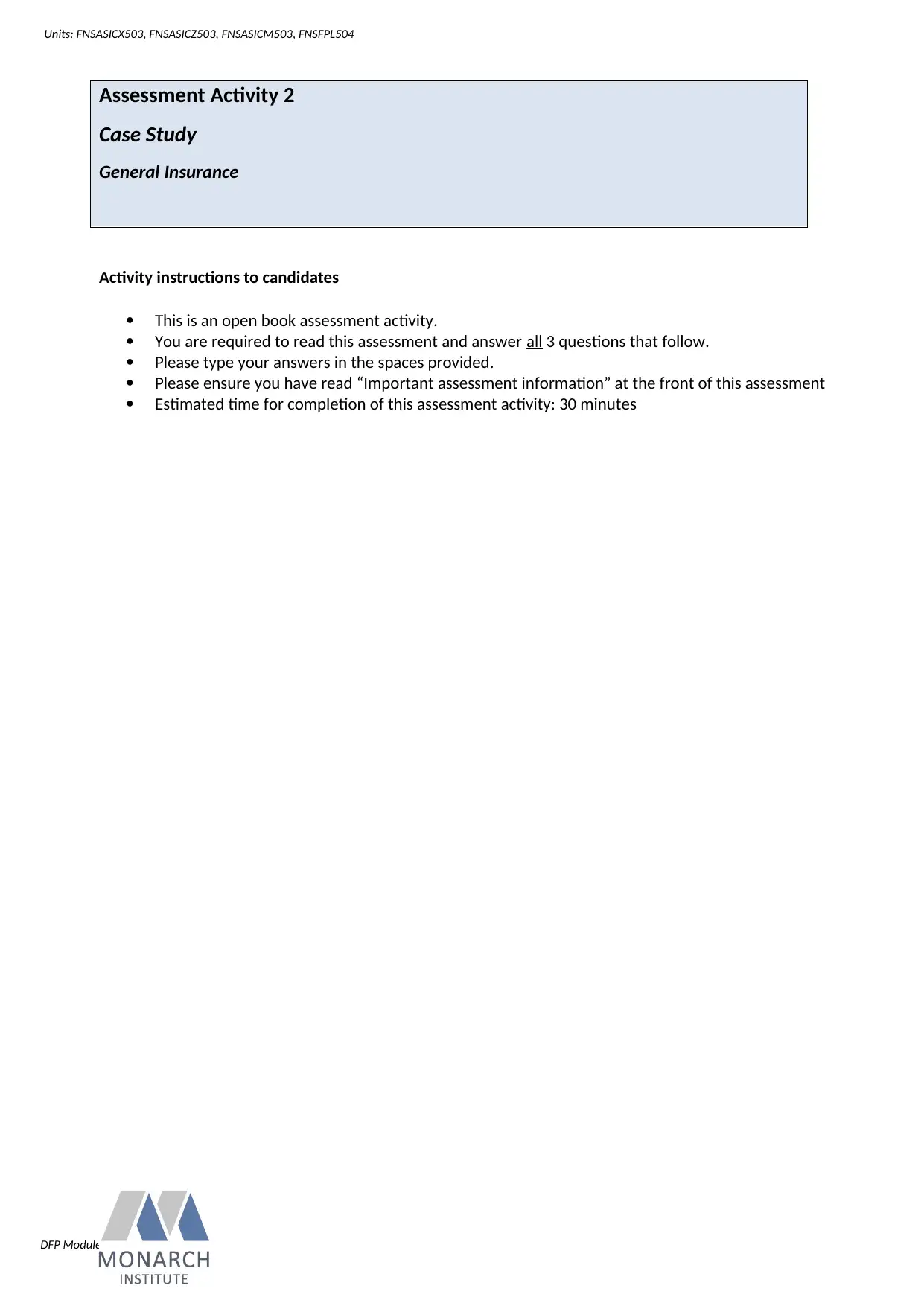
DFP Module 4 Assignment 1601
Units: FNSASICX503, FNSASICZ503, FNSASICM503, FNSFPL504
Assessment Activity 2
Case Study
General Insurance
Activity instructions to candidates
This is an open book assessment activity.
You are required to read this assessment and answer all 3 questions that follow.
Please type your answers in the spaces provided.
Please ensure you have read “Important assessment information” at the front of this assessment
Estimated time for completion of this assessment activity: 30 minutes
Units: FNSASICX503, FNSASICZ503, FNSASICM503, FNSFPL504
Assessment Activity 2
Case Study
General Insurance
Activity instructions to candidates
This is an open book assessment activity.
You are required to read this assessment and answer all 3 questions that follow.
Please type your answers in the spaces provided.
Please ensure you have read “Important assessment information” at the front of this assessment
Estimated time for completion of this assessment activity: 30 minutes
Paraphrase This Document
Need a fresh take? Get an instant paraphrase of this document with our AI Paraphraser
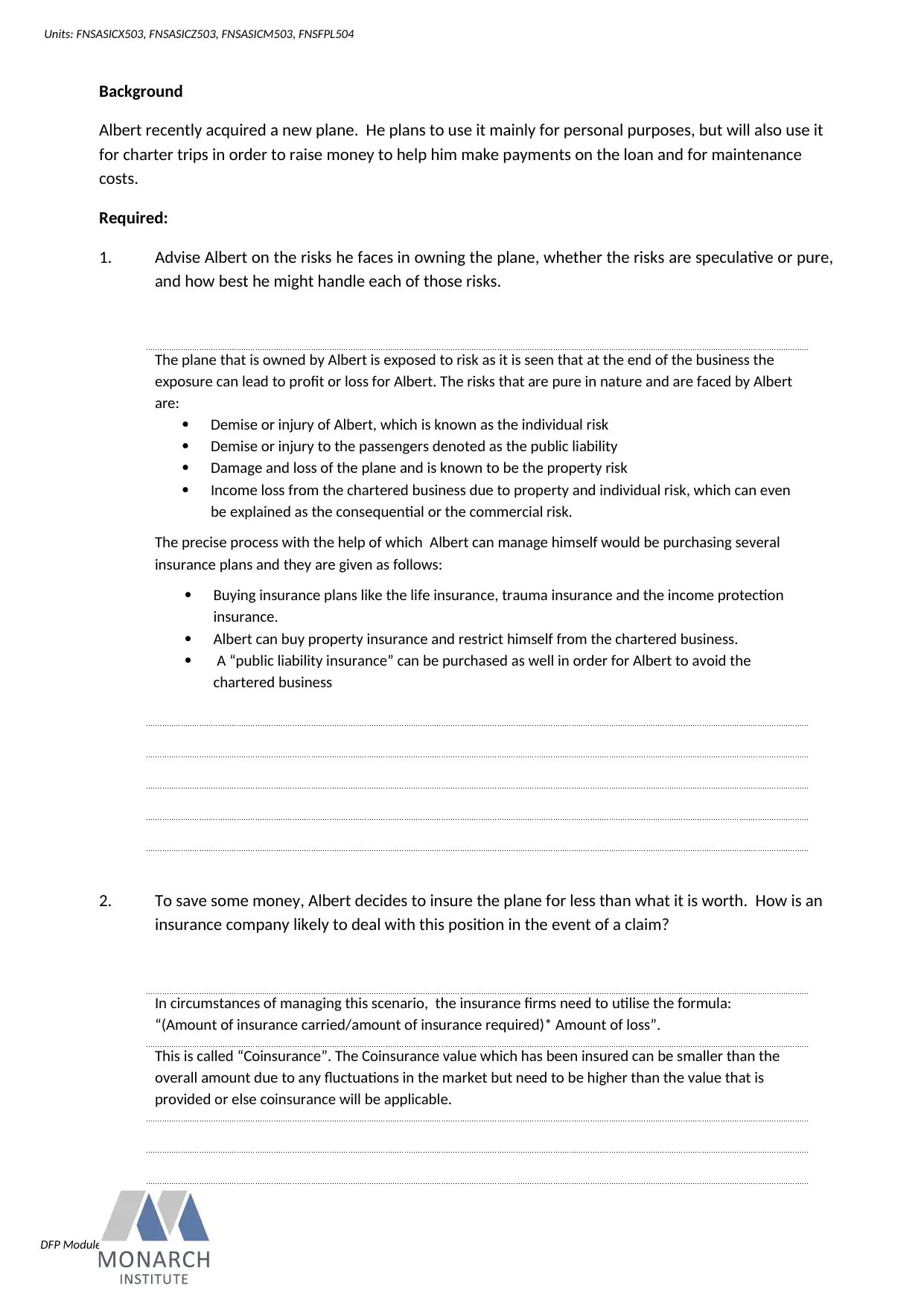
DFP Module 4 Assignment 1601
Units: FNSASICX503, FNSASICZ503, FNSASICM503, FNSFPL504
Background
Albert recently acquired a new plane. He plans to use it mainly for personal purposes, but will also use it
for charter trips in order to raise money to help him make payments on the loan and for maintenance
costs.
Required:
1. Advise Albert on the risks he faces in owning the plane, whether the risks are speculative or pure,
and how best he might handle each of those risks.
The plane that is owned by Albert is exposed to risk as it is seen that at the end of the business the
exposure can lead to profit or loss for Albert. The risks that are pure in nature and are faced by Albert
are:
Demise or injury of Albert, which is known as the individual risk
Demise or injury to the passengers denoted as the public liability
Damage and loss of the plane and is known to be the property risk
Income loss from the chartered business due to property and individual risk, which can even
be explained as the consequential or the commercial risk.
The precise process with the help of which Albert can manage himself would be purchasing several
insurance plans and they are given as follows:
Buying insurance plans like the life insurance, trauma insurance and the income protection
insurance.
Albert can buy property insurance and restrict himself from the chartered business.
A “public liability insurance” can be purchased as well in order for Albert to avoid the
chartered business
2. To save some money, Albert decides to insure the plane for less than what it is worth. How is an
insurance company likely to deal with this position in the event of a claim?
In circumstances of managing this scenario, the insurance firms need to utilise the formula:
“(Amount of insurance carried/amount of insurance required)* Amount of loss”.
This is called “Coinsurance”. The Coinsurance value which has been insured can be smaller than the
overall amount due to any fluctuations in the market but need to be higher than the value that is
provided or else coinsurance will be applicable.
Units: FNSASICX503, FNSASICZ503, FNSASICM503, FNSFPL504
Background
Albert recently acquired a new plane. He plans to use it mainly for personal purposes, but will also use it
for charter trips in order to raise money to help him make payments on the loan and for maintenance
costs.
Required:
1. Advise Albert on the risks he faces in owning the plane, whether the risks are speculative or pure,
and how best he might handle each of those risks.
The plane that is owned by Albert is exposed to risk as it is seen that at the end of the business the
exposure can lead to profit or loss for Albert. The risks that are pure in nature and are faced by Albert
are:
Demise or injury of Albert, which is known as the individual risk
Demise or injury to the passengers denoted as the public liability
Damage and loss of the plane and is known to be the property risk
Income loss from the chartered business due to property and individual risk, which can even
be explained as the consequential or the commercial risk.
The precise process with the help of which Albert can manage himself would be purchasing several
insurance plans and they are given as follows:
Buying insurance plans like the life insurance, trauma insurance and the income protection
insurance.
Albert can buy property insurance and restrict himself from the chartered business.
A “public liability insurance” can be purchased as well in order for Albert to avoid the
chartered business
2. To save some money, Albert decides to insure the plane for less than what it is worth. How is an
insurance company likely to deal with this position in the event of a claim?
In circumstances of managing this scenario, the insurance firms need to utilise the formula:
“(Amount of insurance carried/amount of insurance required)* Amount of loss”.
This is called “Coinsurance”. The Coinsurance value which has been insured can be smaller than the
overall amount due to any fluctuations in the market but need to be higher than the value that is
provided or else coinsurance will be applicable.
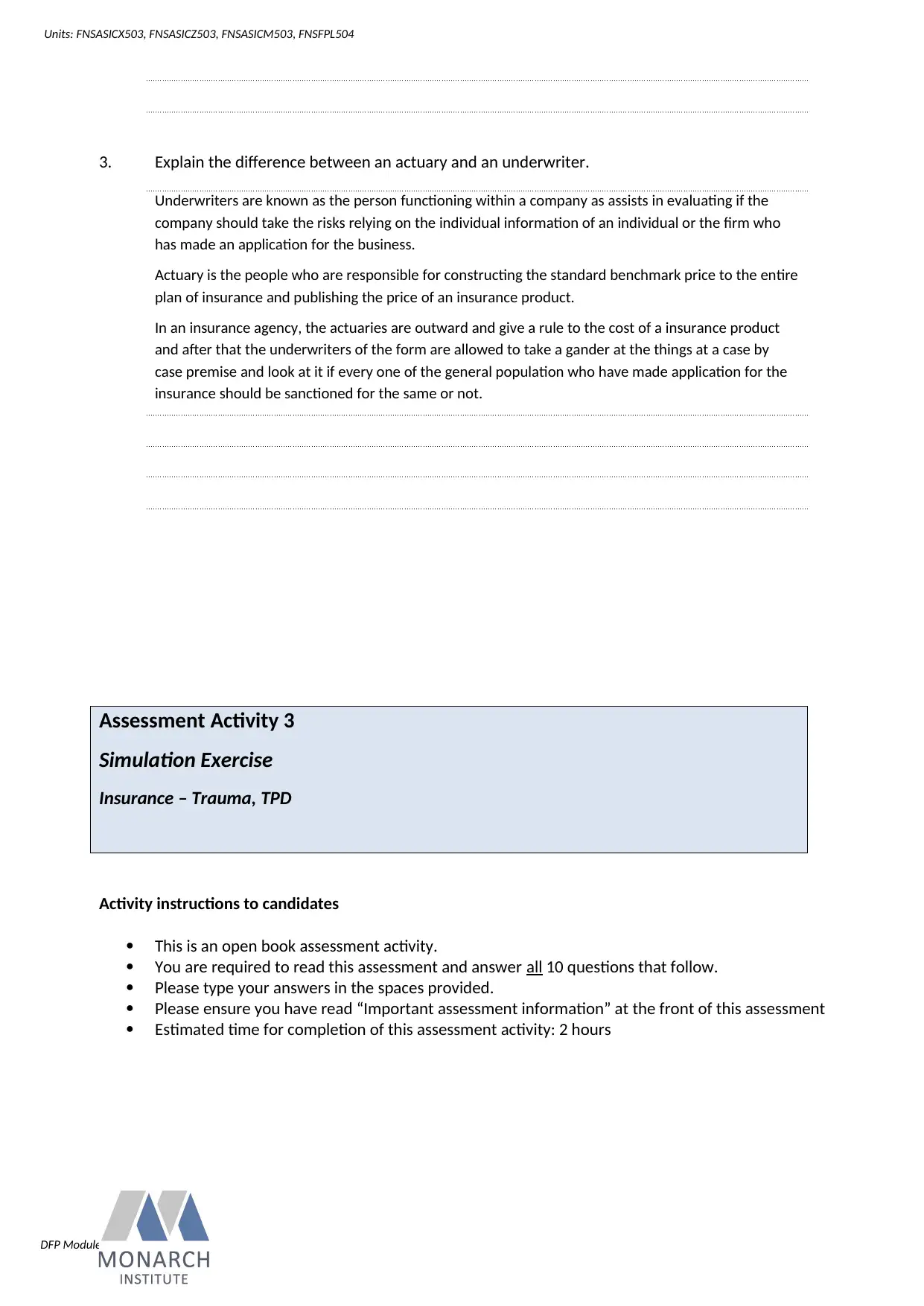
DFP Module 4 Assignment 1601
Units: FNSASICX503, FNSASICZ503, FNSASICM503, FNSFPL504
3. Explain the difference between an actuary and an underwriter.
Underwriters are known as the person functioning within a company as assists in evaluating if the
company should take the risks relying on the individual information of an individual or the firm who
has made an application for the business.
Actuary is the people who are responsible for constructing the standard benchmark price to the entire
plan of insurance and publishing the price of an insurance product.
In an insurance agency, the actuaries are outward and give a rule to the cost of a insurance product
and after that the underwriters of the form are allowed to take a gander at the things at a case by
case premise and look at it if every one of the general population who have made application for the
insurance should be sanctioned for the same or not.
Assessment Activity 3
Simulation Exercise
Insurance – Trauma, TPD
Activity instructions to candidates
This is an open book assessment activity.
You are required to read this assessment and answer all 10 questions that follow.
Please type your answers in the spaces provided.
Please ensure you have read “Important assessment information” at the front of this assessment
Estimated time for completion of this assessment activity: 2 hours
Units: FNSASICX503, FNSASICZ503, FNSASICM503, FNSFPL504
3. Explain the difference between an actuary and an underwriter.
Underwriters are known as the person functioning within a company as assists in evaluating if the
company should take the risks relying on the individual information of an individual or the firm who
has made an application for the business.
Actuary is the people who are responsible for constructing the standard benchmark price to the entire
plan of insurance and publishing the price of an insurance product.
In an insurance agency, the actuaries are outward and give a rule to the cost of a insurance product
and after that the underwriters of the form are allowed to take a gander at the things at a case by
case premise and look at it if every one of the general population who have made application for the
insurance should be sanctioned for the same or not.
Assessment Activity 3
Simulation Exercise
Insurance – Trauma, TPD
Activity instructions to candidates
This is an open book assessment activity.
You are required to read this assessment and answer all 10 questions that follow.
Please type your answers in the spaces provided.
Please ensure you have read “Important assessment information” at the front of this assessment
Estimated time for completion of this assessment activity: 2 hours
⊘ This is a preview!⊘
Do you want full access?
Subscribe today to unlock all pages.

Trusted by 1+ million students worldwide
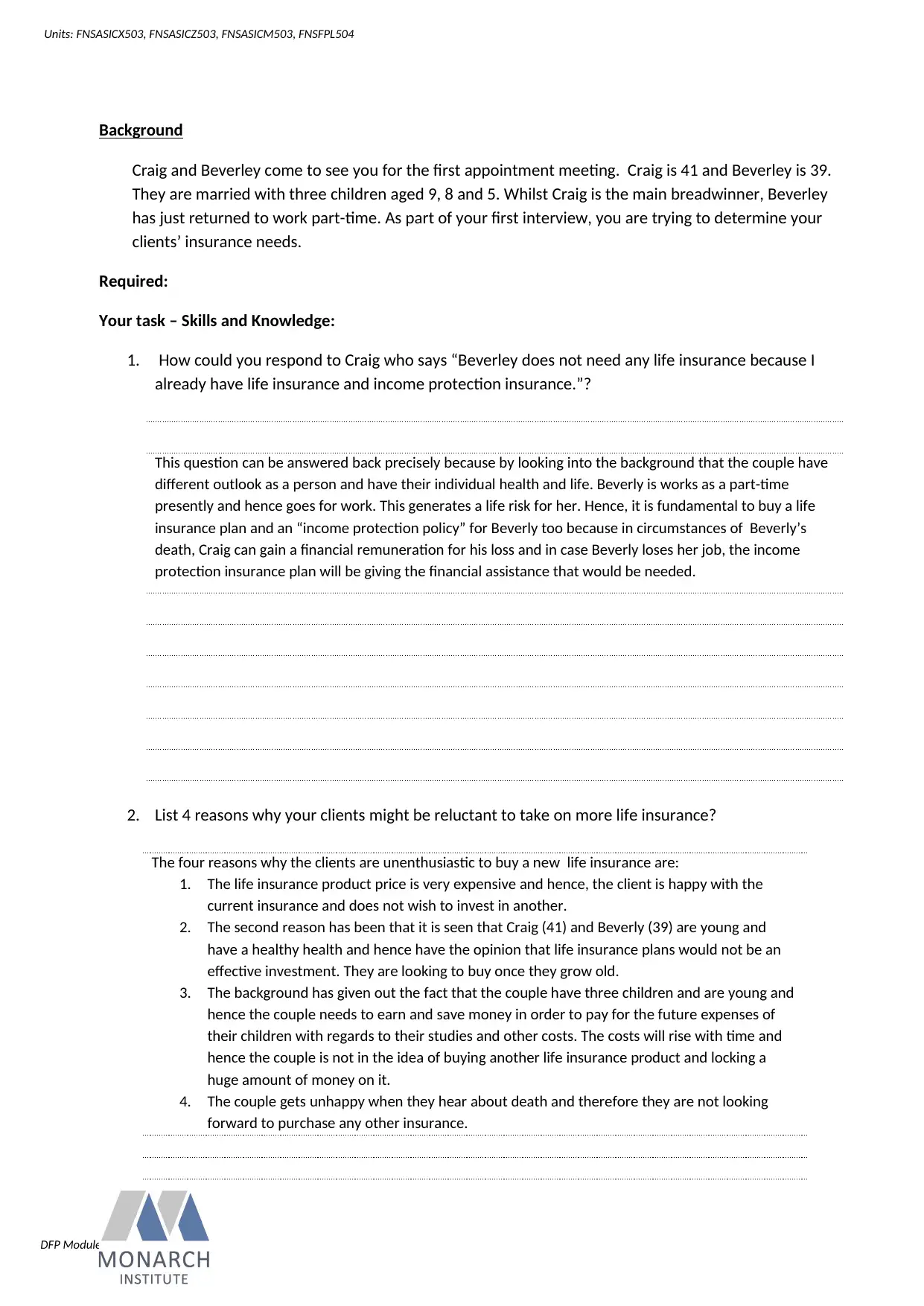
DFP Module 4 Assignment 1601
Units: FNSASICX503, FNSASICZ503, FNSASICM503, FNSFPL504
Background
Craig and Beverley come to see you for the first appointment meeting. Craig is 41 and Beverley is 39.
They are married with three children aged 9, 8 and 5. Whilst Craig is the main breadwinner, Beverley
has just returned to work part-time. As part of your first interview, you are trying to determine your
clients’ insurance needs.
Required:
Your task – Skills and Knowledge:
1. How could you respond to Craig who says “Beverley does not need any life insurance because I
already have life insurance and income protection insurance.”?
This question can be answered back precisely because by looking into the background that the couple have
different outlook as a person and have their individual health and life. Beverly is works as a part-time
presently and hence goes for work. This generates a life risk for her. Hence, it is fundamental to buy a life
insurance plan and an “income protection policy” for Beverly too because in circumstances of Beverly’s
death, Craig can gain a financial remuneration for his loss and in case Beverly loses her job, the income
protection insurance plan will be giving the financial assistance that would be needed.
2. List 4 reasons why your clients might be reluctant to take on more life insurance?
The four reasons why the clients are unenthusiastic to buy a new life insurance are:
1. The life insurance product price is very expensive and hence, the client is happy with the
current insurance and does not wish to invest in another.
2. The second reason has been that it is seen that Craig (41) and Beverly (39) are young and
have a healthy health and hence have the opinion that life insurance plans would not be an
effective investment. They are looking to buy once they grow old.
3. The background has given out the fact that the couple have three children and are young and
hence the couple needs to earn and save money in order to pay for the future expenses of
their children with regards to their studies and other costs. The costs will rise with time and
hence the couple is not in the idea of buying another life insurance product and locking a
huge amount of money on it.
4. The couple gets unhappy when they hear about death and therefore they are not looking
forward to purchase any other insurance.
Units: FNSASICX503, FNSASICZ503, FNSASICM503, FNSFPL504
Background
Craig and Beverley come to see you for the first appointment meeting. Craig is 41 and Beverley is 39.
They are married with three children aged 9, 8 and 5. Whilst Craig is the main breadwinner, Beverley
has just returned to work part-time. As part of your first interview, you are trying to determine your
clients’ insurance needs.
Required:
Your task – Skills and Knowledge:
1. How could you respond to Craig who says “Beverley does not need any life insurance because I
already have life insurance and income protection insurance.”?
This question can be answered back precisely because by looking into the background that the couple have
different outlook as a person and have their individual health and life. Beverly is works as a part-time
presently and hence goes for work. This generates a life risk for her. Hence, it is fundamental to buy a life
insurance plan and an “income protection policy” for Beverly too because in circumstances of Beverly’s
death, Craig can gain a financial remuneration for his loss and in case Beverly loses her job, the income
protection insurance plan will be giving the financial assistance that would be needed.
2. List 4 reasons why your clients might be reluctant to take on more life insurance?
The four reasons why the clients are unenthusiastic to buy a new life insurance are:
1. The life insurance product price is very expensive and hence, the client is happy with the
current insurance and does not wish to invest in another.
2. The second reason has been that it is seen that Craig (41) and Beverly (39) are young and
have a healthy health and hence have the opinion that life insurance plans would not be an
effective investment. They are looking to buy once they grow old.
3. The background has given out the fact that the couple have three children and are young and
hence the couple needs to earn and save money in order to pay for the future expenses of
their children with regards to their studies and other costs. The costs will rise with time and
hence the couple is not in the idea of buying another life insurance product and locking a
huge amount of money on it.
4. The couple gets unhappy when they hear about death and therefore they are not looking
forward to purchase any other insurance.
Paraphrase This Document
Need a fresh take? Get an instant paraphrase of this document with our AI Paraphraser
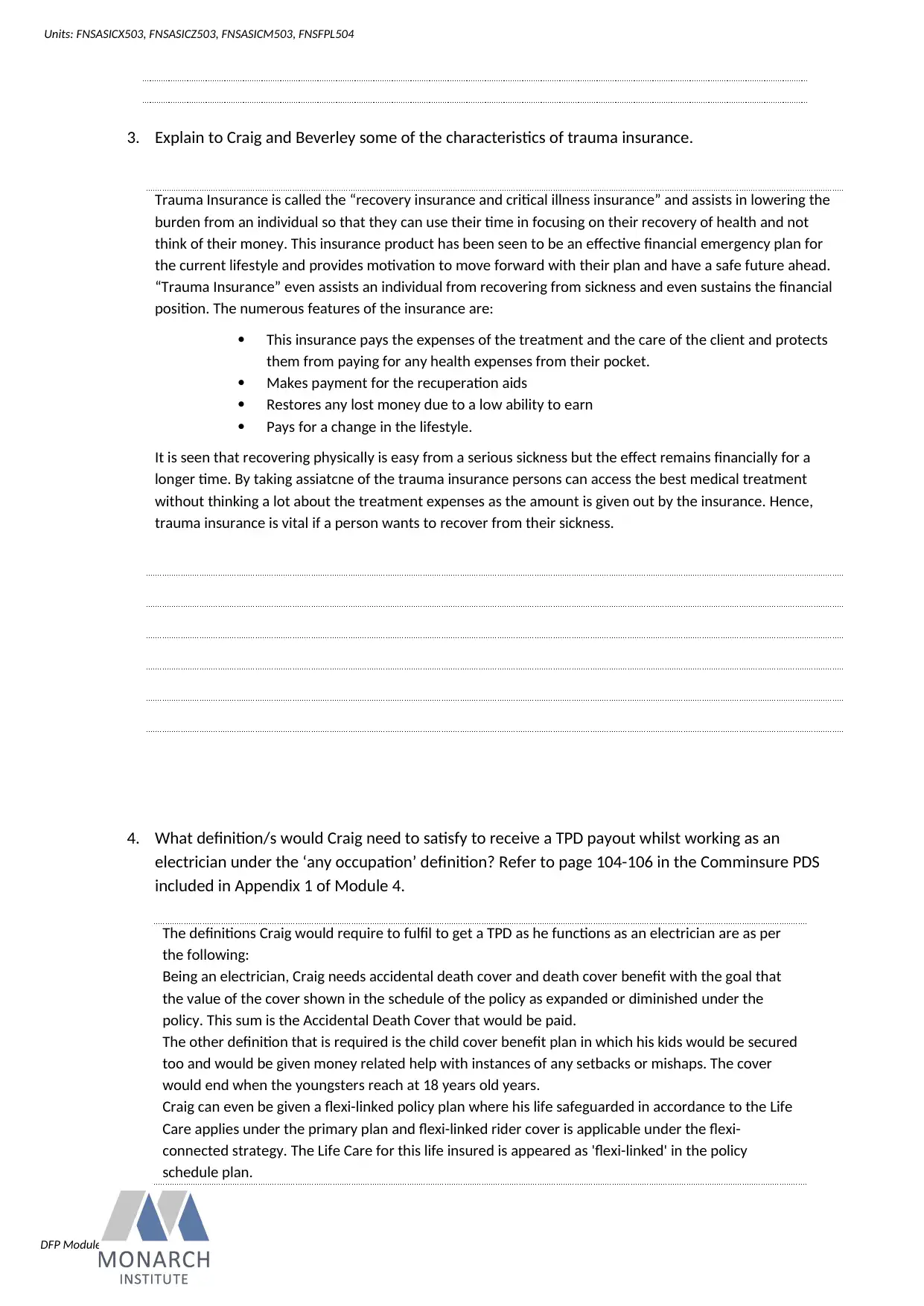
DFP Module 4 Assignment 1601
Units: FNSASICX503, FNSASICZ503, FNSASICM503, FNSFPL504
3. Explain to Craig and Beverley some of the characteristics of trauma insurance.
Trauma Insurance is called the “recovery insurance and critical illness insurance” and assists in lowering the
burden from an individual so that they can use their time in focusing on their recovery of health and not
think of their money. This insurance product has been seen to be an effective financial emergency plan for
the current lifestyle and provides motivation to move forward with their plan and have a safe future ahead.
“Trauma Insurance” even assists an individual from recovering from sickness and even sustains the financial
position. The numerous features of the insurance are:
This insurance pays the expenses of the treatment and the care of the client and protects
them from paying for any health expenses from their pocket.
Makes payment for the recuperation aids
Restores any lost money due to a low ability to earn
Pays for a change in the lifestyle.
It is seen that recovering physically is easy from a serious sickness but the effect remains financially for a
longer time. By taking assiatcne of the trauma insurance persons can access the best medical treatment
without thinking a lot about the treatment expenses as the amount is given out by the insurance. Hence,
trauma insurance is vital if a person wants to recover from their sickness.
4. What definition/s would Craig need to satisfy to receive a TPD payout whilst working as an
electrician under the ‘any occupation’ definition? Refer to page 104-106 in the Comminsure PDS
included in Appendix 1 of Module 4.
The definitions Craig would require to fulfil to get a TPD as he functions as an electrician are as per
the following:
Being an electrician, Craig needs accidental death cover and death cover benefit with the goal that
the value of the cover shown in the schedule of the policy as expanded or diminished under the
policy. This sum is the Accidental Death Cover that would be paid.
The other definition that is required is the child cover benefit plan in which his kids would be secured
too and would be given money related help with instances of any setbacks or mishaps. The cover
would end when the youngsters reach at 18 years old years.
Craig can even be given a flexi-linked policy plan where his life safeguarded in accordance to the Life
Care applies under the primary plan and flexi-linked rider cover is applicable under the flexi-
connected strategy. The Life Care for this life insured is appeared as 'flexi-linked' in the policy
schedule plan.
Units: FNSASICX503, FNSASICZ503, FNSASICM503, FNSFPL504
3. Explain to Craig and Beverley some of the characteristics of trauma insurance.
Trauma Insurance is called the “recovery insurance and critical illness insurance” and assists in lowering the
burden from an individual so that they can use their time in focusing on their recovery of health and not
think of their money. This insurance product has been seen to be an effective financial emergency plan for
the current lifestyle and provides motivation to move forward with their plan and have a safe future ahead.
“Trauma Insurance” even assists an individual from recovering from sickness and even sustains the financial
position. The numerous features of the insurance are:
This insurance pays the expenses of the treatment and the care of the client and protects
them from paying for any health expenses from their pocket.
Makes payment for the recuperation aids
Restores any lost money due to a low ability to earn
Pays for a change in the lifestyle.
It is seen that recovering physically is easy from a serious sickness but the effect remains financially for a
longer time. By taking assiatcne of the trauma insurance persons can access the best medical treatment
without thinking a lot about the treatment expenses as the amount is given out by the insurance. Hence,
trauma insurance is vital if a person wants to recover from their sickness.
4. What definition/s would Craig need to satisfy to receive a TPD payout whilst working as an
electrician under the ‘any occupation’ definition? Refer to page 104-106 in the Comminsure PDS
included in Appendix 1 of Module 4.
The definitions Craig would require to fulfil to get a TPD as he functions as an electrician are as per
the following:
Being an electrician, Craig needs accidental death cover and death cover benefit with the goal that
the value of the cover shown in the schedule of the policy as expanded or diminished under the
policy. This sum is the Accidental Death Cover that would be paid.
The other definition that is required is the child cover benefit plan in which his kids would be secured
too and would be given money related help with instances of any setbacks or mishaps. The cover
would end when the youngsters reach at 18 years old years.
Craig can even be given a flexi-linked policy plan where his life safeguarded in accordance to the Life
Care applies under the primary plan and flexi-linked rider cover is applicable under the flexi-
connected strategy. The Life Care for this life insured is appeared as 'flexi-linked' in the policy
schedule plan.
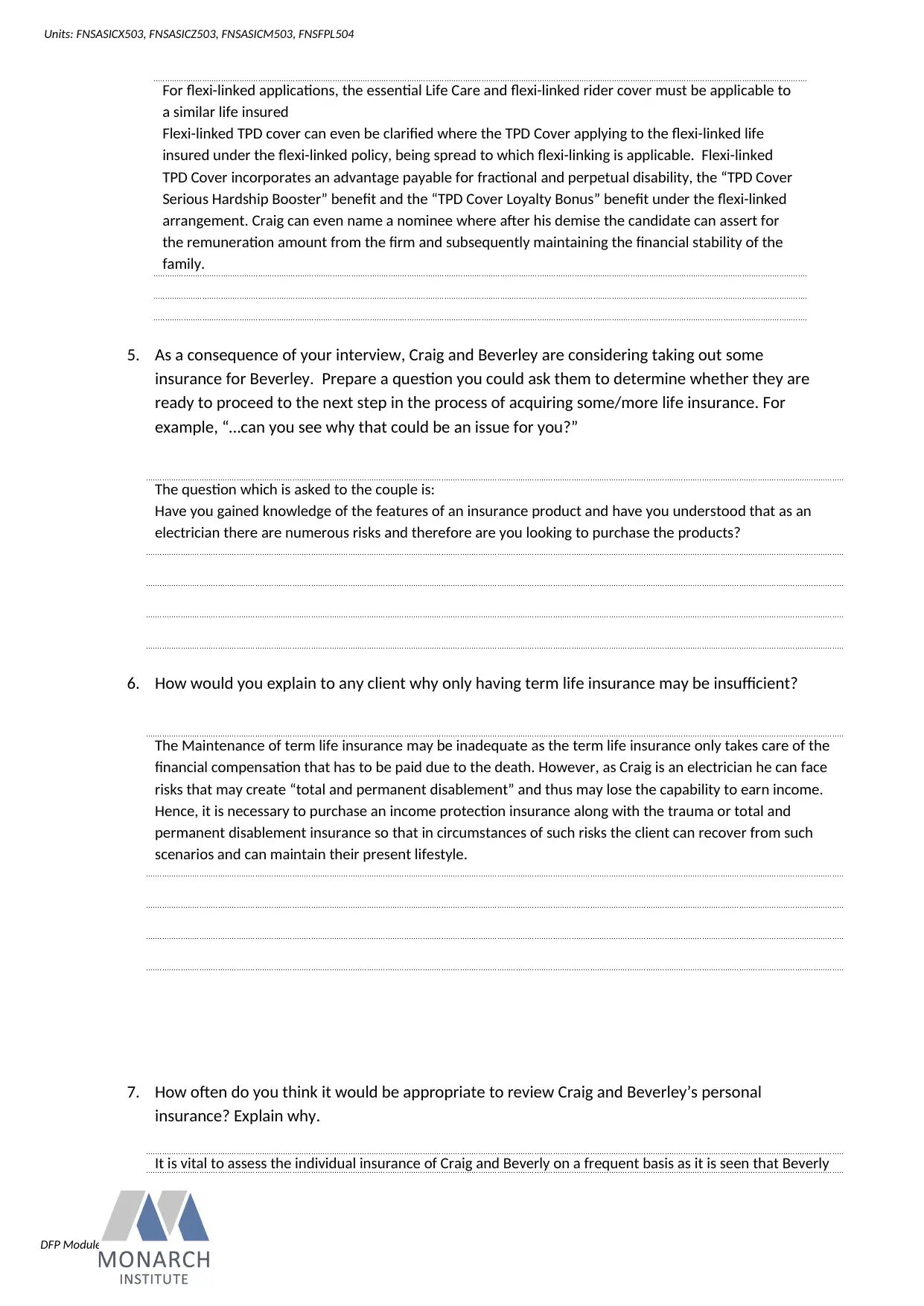
DFP Module 4 Assignment 1601
Units: FNSASICX503, FNSASICZ503, FNSASICM503, FNSFPL504
For flexi-linked applications, the essential Life Care and flexi-linked rider cover must be applicable to
a similar life insured
Flexi-linked TPD cover can even be clarified where the TPD Cover applying to the flexi-linked life
insured under the flexi-linked policy, being spread to which flexi-linking is applicable. Flexi-linked
TPD Cover incorporates an advantage payable for fractional and perpetual disability, the “TPD Cover
Serious Hardship Booster” benefit and the “TPD Cover Loyalty Bonus” benefit under the flexi-linked
arrangement. Craig can even name a nominee where after his demise the candidate can assert for
the remuneration amount from the firm and subsequently maintaining the financial stability of the
family.
5. As a consequence of your interview, Craig and Beverley are considering taking out some
insurance for Beverley. Prepare a question you could ask them to determine whether they are
ready to proceed to the next step in the process of acquiring some/more life insurance. For
example, “…can you see why that could be an issue for you?”
The question which is asked to the couple is:
Have you gained knowledge of the features of an insurance product and have you understood that as an
electrician there are numerous risks and therefore are you looking to purchase the products?
6. How would you explain to any client why only having term life insurance may be insufficient?
The Maintenance of term life insurance may be inadequate as the term life insurance only takes care of the
financial compensation that has to be paid due to the death. However, as Craig is an electrician he can face
risks that may create “total and permanent disablement” and thus may lose the capability to earn income.
Hence, it is necessary to purchase an income protection insurance along with the trauma or total and
permanent disablement insurance so that in circumstances of such risks the client can recover from such
scenarios and can maintain their present lifestyle.
7. How often do you think it would be appropriate to review Craig and Beverley’s personal
insurance? Explain why.
It is vital to assess the individual insurance of Craig and Beverly on a frequent basis as it is seen that Beverly
Units: FNSASICX503, FNSASICZ503, FNSASICM503, FNSFPL504
For flexi-linked applications, the essential Life Care and flexi-linked rider cover must be applicable to
a similar life insured
Flexi-linked TPD cover can even be clarified where the TPD Cover applying to the flexi-linked life
insured under the flexi-linked policy, being spread to which flexi-linking is applicable. Flexi-linked
TPD Cover incorporates an advantage payable for fractional and perpetual disability, the “TPD Cover
Serious Hardship Booster” benefit and the “TPD Cover Loyalty Bonus” benefit under the flexi-linked
arrangement. Craig can even name a nominee where after his demise the candidate can assert for
the remuneration amount from the firm and subsequently maintaining the financial stability of the
family.
5. As a consequence of your interview, Craig and Beverley are considering taking out some
insurance for Beverley. Prepare a question you could ask them to determine whether they are
ready to proceed to the next step in the process of acquiring some/more life insurance. For
example, “…can you see why that could be an issue for you?”
The question which is asked to the couple is:
Have you gained knowledge of the features of an insurance product and have you understood that as an
electrician there are numerous risks and therefore are you looking to purchase the products?
6. How would you explain to any client why only having term life insurance may be insufficient?
The Maintenance of term life insurance may be inadequate as the term life insurance only takes care of the
financial compensation that has to be paid due to the death. However, as Craig is an electrician he can face
risks that may create “total and permanent disablement” and thus may lose the capability to earn income.
Hence, it is necessary to purchase an income protection insurance along with the trauma or total and
permanent disablement insurance so that in circumstances of such risks the client can recover from such
scenarios and can maintain their present lifestyle.
7. How often do you think it would be appropriate to review Craig and Beverley’s personal
insurance? Explain why.
It is vital to assess the individual insurance of Craig and Beverly on a frequent basis as it is seen that Beverly
⊘ This is a preview!⊘
Do you want full access?
Subscribe today to unlock all pages.

Trusted by 1+ million students worldwide
1 out of 30
Related Documents
Your All-in-One AI-Powered Toolkit for Academic Success.
+13062052269
info@desklib.com
Available 24*7 on WhatsApp / Email
![[object Object]](/_next/static/media/star-bottom.7253800d.svg)
Unlock your academic potential
Copyright © 2020–2025 A2Z Services. All Rights Reserved. Developed and managed by ZUCOL.




